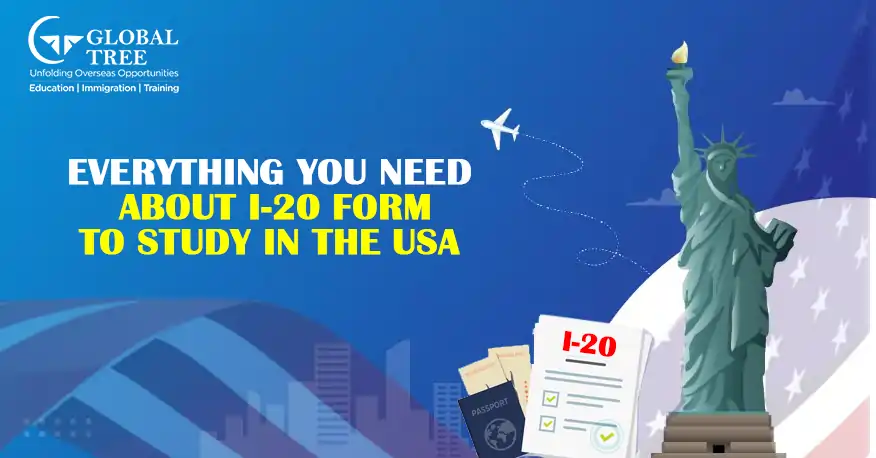Everything You Need to Know About I-20 Form to Study in the USA

Introduction
Are you worried about studying in the USA and that you'll need an I-20 form to enter the country?
You're not alone. Lots of people have misgivings about studying in the US because they don't know what the I-20 form is or how it works.
In this comprehensive article guide, we'll delve deep into the I-20 form, explaining its significance, how to obtain it, and what responsibilities it entails.
So, let's get started on unraveling everything you need to know about the I-20 form to study in the USA.
What is the I-20 Form?
The I-20 form, also known as the Certificate of Eligibility for Nonimmigrant Student Status, is a critical document issued by accredited U.S. schools and universities.
It serves as proof that you have been accepted to a Student and Exchange Visitor Program (SEVP) - approved institution, and that you are eligible to apply for an F-1 student visa or maintain your current F-1 student status in the USA.
This seemingly simple piece of paper holds immense importance in your journey to study in the USA. It is not just a form but a representation of your intent to study and obey U.S. immigration laws. The I-20 form includes crucial information about your program, finances, and the start and end dates of your studies.
The Significance of the I-20 Form: Why do you need it?
Understanding the significance of the I-20 form is essential for any international student planning to study in the USA. Here are some key aspects to consider:
1. Legal Status:
The I-20 form plays a pivotal role in establishing your legal status as an international student in the USA. It is a legally binding document that certifies your eligibility to pursue a full-time academic program and, consequently, to maintain your F-1 student status.
2. Visa Application:
To obtain an F-1 student visa, you will need your I-20 form. The information on the I-20 is essential for the visa application process, and you must present it during your visa interview at the U.S. embassy or consulate in your home country.
3. Enrollment Verification:
Your I-20 form is used to verify your enrollment and academic progress at your U.S. institution. It should be kept updated and accurate to avoid any issues with U.S. immigration authorities.
4. Employment Authorization:
If you plan to work on or off-campus during your studies, your I-20 form will be required to apply for employment authorization, such as Optional Practical Training (OPT) or Curricular Practical Training (CPT).
5. Travel:
When traveling to and from the USA, you'll need your I-20 form. Ensure that it is signed by your Designated School Official (DSO) to indicate your eligibility for reentry into the country.
Obtaining Your I-20 Form
Now that you understand the importance of the I-20 form let's delve into how you can obtain it.
1. Admission to a SEVP-Approved School:
The first step in obtaining your I-20 form is gaining admission to a U.S. school or university that is certified by the SEVP. Ensure that you apply to institutions that are eligible to issue I-20 forms to international students.
2. Financial Documentation:
To prove that you can financially support your studies and living expenses in the USA, you will need to provide financial documentation to your school. This typically includes bank statements, scholarship letters, or sponsorship letters.
3. Receive Form I-20:
Once you have been accepted by a SEVP-approved institution and have provided the necessary financial documentation, the school's DSO will issue your Form I-20. This will include your program start date, program end date, and other essential details.
4. Pay the SEVIS Fee:
Before scheduling your visa appointment or entering the USA, you must pay the Student and Exchange Visitor Information System (SEVIS) fee. This fee helps fund the administration of the SEVP and the maintenance of your immigration records. You can pay the SEVIS fee online and should keep the receipt as proof of payment.
5. Visa Application:
With your I-20 form and SEVIS fee payment receipt in hand, you can proceed to apply for an F-1 student visa at the U.S. embassy or consulate in your home country. The visa application process for the USA may require an interview, so be prepared to answer questions about your intended course of study, finances, and ties to your home country.
6. Travel to the USA:
Once your F-1 student visa is approved, you can make travel arrangements to the USA. Remember to carry your I-20 form, visa, and other essential documents with you when you travel.
Where should the I-20 Form be sent?
The I-20 form should be sent directly to the international student who has been accepted by a SEVP-approved U.S. school or university.
Typically, the designated school official (DSO) at the institution will issue the I-20 form and mail it to the student's international address.
It's important for the student to ensure that the information on the I-20 is accurate, including their name, program start date, and program end date, as this information is necessary for the student visa application process and for maintaining legal status in the United States.
Once the student receives the I-20 form, they should keep it in a safe and secure place, as it is a critical document for their immigration status in the U.S. It will be needed for the visa application, entry into the U.S., and various other immigration-related purposes.
If there are any errors on the I-20 or if there are changes to the program of study, the student should promptly contact their DSO to have the necessary corrections made.
How long does it take for the processing of the I-20 Form?
The processing time for an I-20 form can vary depending on the specific U.S. school or university you have been admitted to and their administrative processes.
Generally, it is advisable to start the application process well in advance to ensure you receive your I-20 form in a timely manner. Here are some factors that can influence the processing time:
- School's Administrative Process: Each school may have its own procedures and processing times for issuing I-20 forms. Some institutions have streamlined processes and can issue the I-20 relatively quickly, while others may take longer.
- Admission Timeline: The timing of your admission to the school can affect when you receive your I-20. If you are admitted close to the start date of your program, the school may expedite the processing to ensure you have the necessary documents in time.
- Completeness of Documentation: Providing all the required documentation and financial information promptly for a F1 Visa can help speed up the processing. Delays can occur if there are missing or incomplete documents.
- SEVIS Fee Payment: Before the I-20 can be issued, you must pay the Student and Exchange Visitor Information System (SEVIS) fee. Make sure to complete this step promptly and keep the payment receipt as proof.
- Communication with the Designated School Official (DSO): Maintaining clear and open communication with your DSO can help expedite the process. They can guide you on what documents are needed and provide updates on the status of your I-20.
- Time of Year: Processing times may vary depending on the time of year. It's common for schools to experience higher volumes of requests leading up to the start of a new semester, which can lead to longer processing times.
It is best to contact the international student office or DSO you have been admitted to, to get an accurate estimation of the processing time.
They can provide you with information on their processing timelines and any specific requirements they may have.
Starting the application process early and staying organized with your documentation can help ensure a smoother and more timely issuance of your I-20 form.
Also Know: What is an M1 Visa and Which visa is the best for you?
Responsibilities as an F-1 Visa Holder
Securing your I-20 form and F-1 student visa is just the beginning of your journey to study in the USA. As an F-1 visa holder, you have certain responsibilities to ensure that you maintain your legal status and have a successful academic experience:
1. Full-Time Enrollment:
You must enroll in and complete a full-time academic program during the regular academic year. Failure to do so could jeopardize your F-1 status.
2. Valid I-20:
Keep your I-20 form up to date. If there are any changes to your program, such as a change of major or extension of your program end date, you must inform your DSO, and they will update your I-20 accordingly.
3. Address Reporting:
You must report any change of address to your DSO within ten days of the change. This ensures that the U.S. government can reach you with important immigration information.
4. Employment Authorization:
If you plan to work on or off-campus, you must obtain the necessary employment authorization, such as OPT or CPT, and adhere to the regulations regarding work hours and eligibility.
5. Abiding by the Law:
Adhere to all U.S. immigration laws and regulations. This includes not overstaying your visa, not engaging in unauthorized employment, and not violating any other immigration rules.
6. Travel Endorsement:
Before traveling outside the USA, ensure that your I-20 form is properly endorsed by your DSO. This endorsement, often referred to as a travel signature, confirms your eligibility for reentry into the country.
How to get an Visa appointment at the US Embassy?
Maintaining Your F1 Status
Maintaining your F1 visa status is crucial for a successful academic experience in the USA. Here are some additional tips to help you stay on track:
1. Attend Orientation:
Many U.S. universities offer orientation programs for international students. Attend these programs to familiarize yourself with campus resources, immigration regulations, and cultural adjustments.
2. Stay Informed:
Keep yourself informed about any changes in U.S. immigration policies that may affect your status. The rules and regulations can change, so it's essential to stay up to date.
3. Seek Guidance:
If you have any questions or concerns about your immigration status, don't hesitate to reach out to your DSO. They are there to assist you with immigration-related matters.
4. Health Insurance:
Many universities require international students to have health insurance. Make sure you have the necessary coverage to meet those requirements.
Wrapping up!
In summary, the I-20 form is a pivotal document for international students aspiring to study in the USA. It signifies admission to a SEVP-approved institution and compliance with U.S. immigration laws.
Understanding its importance and responsibilities is crucial for a successful academic journey. Stay informed, communicate with your DSO, and keep your I-20 updated for a smooth international student experience in the USA.
FAQ’s
1. What to do if your I-20 form is lost or stolen?
If your I-20 form is lost or stolen, follow these steps:
1. Report Loss: Notify your DSO immediately.
2. Request Replacement: Ask your DSO for a new I-20.
3. Pay Fee: There may be a replacement fee.
4. Keep Records: Maintain records of the incident.
5. Update Visa (if needed): Apply for a new visa if it was also lost.
6. Review New I-20: Check for accuracy.
7. Maintain Status: Attend classes and follow immigration rules.
2. Why Is The I-20 Form Important for International Students?
The I-20 form, also known as the Certificate of Eligibility for Nonimmigrant Student Status, is a document issued by U.S. schools to international students. It's essential because it represents your acceptance at a SEVP-approved institution and serves as proof of your eligibility to apply for an F-1 student visa or maintain your F-1 student status in the USA.
3. What is the SEVIS fee, and when do I pay it?
The SEVIS (Student and Exchange Visitor Information System) fee is a mandatory fee paid by international students to support the administration of the SEVP. It should be paid after receiving the I-20 form and before scheduling a visa interview at the U.S. embassy or consulate.
4. Can I work while on an F-1 visa, and how do I get employment authorization?
Yes, you can work on or off-campus with the appropriate employment authorization. Common types of work authorization for F-1 students include Optional Practical Training (OPT) and Curricular Practical Training (CPT). Your DSO can provide guidance on how to apply for these authorizations.
5. Can I transfer my F-1 status to a different U.S. school?
Yes, you can transfer your F-1 status to another SEVP-approved institution. To do this, you need to notify your current DSO and complete the necessary transfer procedures with your new school's DSO.
6. Can I travel outside the USA with my I-20 form?
Yes, you can travel outside the USA with your I-20, but it must be properly endorsed by your DSO for reentry. Ensure your visa is also valid for reentry.
7. What should I do if there are errors on my I-20 form or if my program details change?
Contact your DSO immediately if there are errors on your I-20 or if any program details change. They will assist in making necessary corrections or updates to your form.
8: How long does it take to receive a replacement I-20 form?
Processing times vary by institution, but most DSOs can issue a replacement I-20 within a few business days. If mailing is required, allow extra time based on your location.
9: Can I receive my I-20 form electronically?
Yes, as per updated SEVP guidance, schools can issue the I-20 electronically with a digital signature. You can receive it via email and print it for visa interviews and travel purposes.
10: Do I need a new I-20 for every visa renewal or travel?
Not necessarily. You only need a new I-20 if your program information has changed, your travel endorsement is outdated, or you're transferring schools. Otherwise, your existing I-20 with a valid travel signature may suffice.
11: What should I do if my SEVIS ID changes?
If you receive a new SEVIS ID due to changing schools or visa status, inform your DSO and repay the SEVIS fee using the new ID. Ensure the updated ID matches all your official records and applications.
12: Can I stay in the U.S. with an expired I-20 form?
No, staying in the U.S. with an expired or invalid I-20 can put you out of status. You must ensure your form is always updated and reflects accurate program dates and personal information.
13: What happens if I withdraw from my program — does the I-20 remain valid?
If you officially withdraw or are terminated from your program, your I-20 becomes invalid. You must leave the U.S. within the grace period (typically 15 days), or take steps to transfer or reinstate your status if eligible.
14: How early can I enter the U.S. with my I-20 form?
You can enter the U.S. up to 30 days before the program start date listed on your I-20. Arriving earlier than that is not allowed under F-1 regulations.
15: Do dependents (F-2 visa holders) also need I-20 forms?
Yes, each dependent (spouse or child) must have their own I-20 form issued by the same institution as the F-1 student. These are required for their F-2 visa applications.







